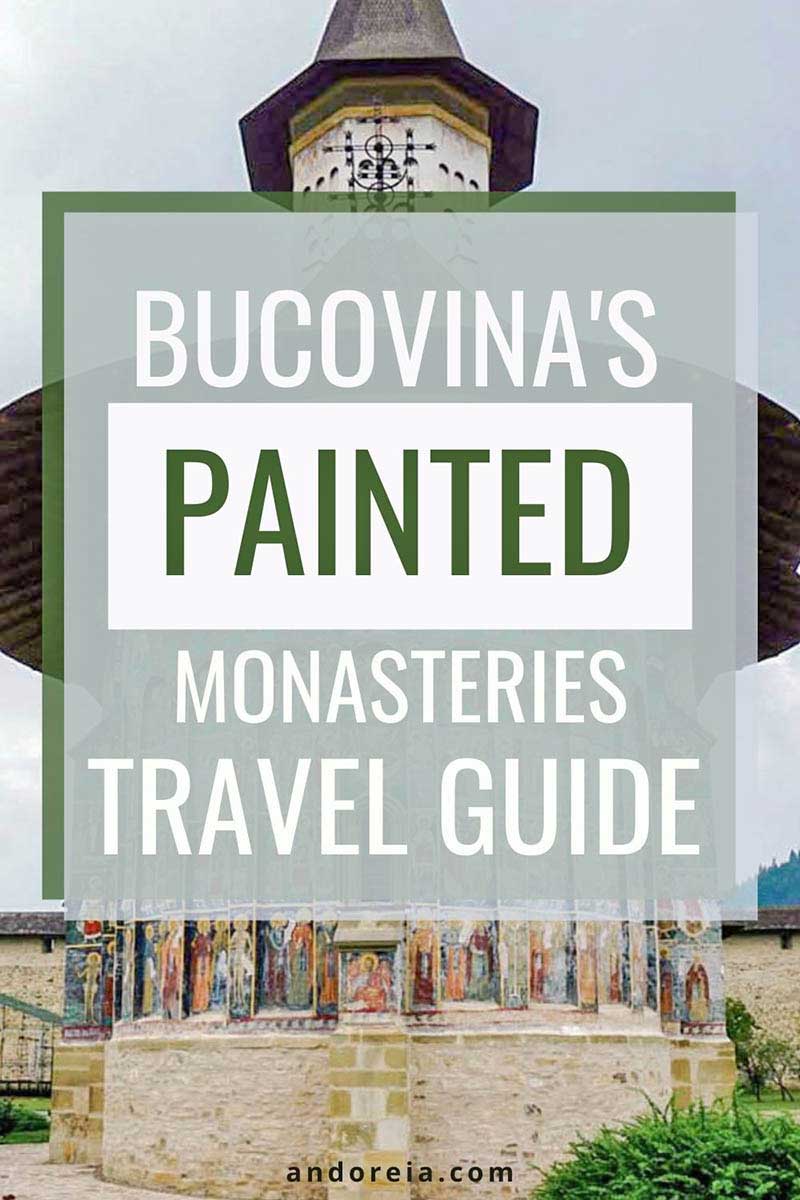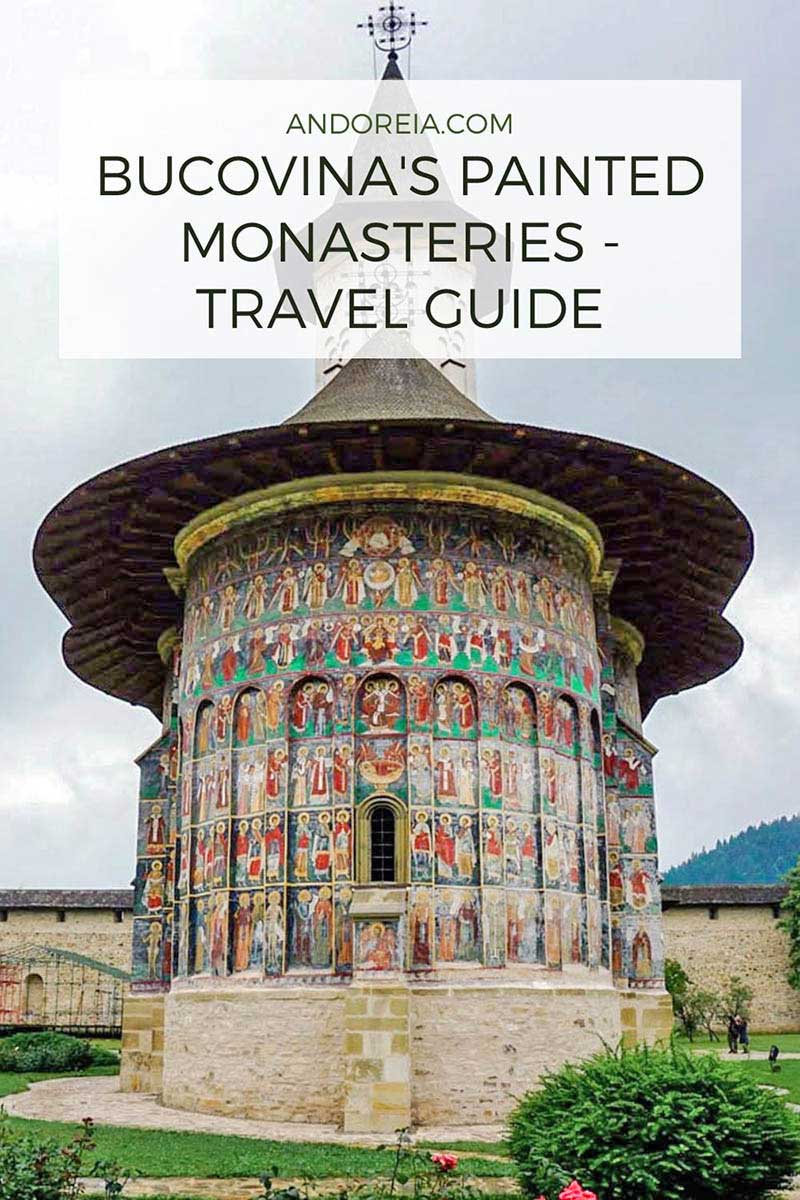While I may not be the most impartial person to make such a statement, I firmly believe that Romania, my homeland, has numerous stunning locations and landmarks to explore, even though it still remains relatively undiscovered by most tourists.
Since Bucovina’s painted monasteries are some of the most famous ones, yet there’s not a ton of information out there about them, I decided to write a travel guide about how to visit these religious sites.
Disclosure: Some of the links in this post are affiliate links. If you click on them and make a purchase, I may receive a commission at no extra cost to you. Check my full disclaimer here.
What are the painted monasteries of Bucovina?
The painted monasteries of Bucovina include several Romanian Orthodox churches in Northern Moldova, whose walls are adorned with vivid depictions of biblical scenes.
What really sets these monasteries apart is not just the interior artwork, but the fact that most of them also have their entire exterior facades painted.
This tradition of painting both the inside and outside of the churches was not merely an artistic choice; it served a functional purpose during the Middle Ages.
In a time when literacy rates were low, these vibrant illustrations acted as visual narratives, educating the masses about biblical stories and teachings.
This distinctive feature has not only given them the nickname of ‘Painted monasteries’ or ‘Painted churches’, but has also cemented their place as unique architectural and cultural landmarks of Romania.
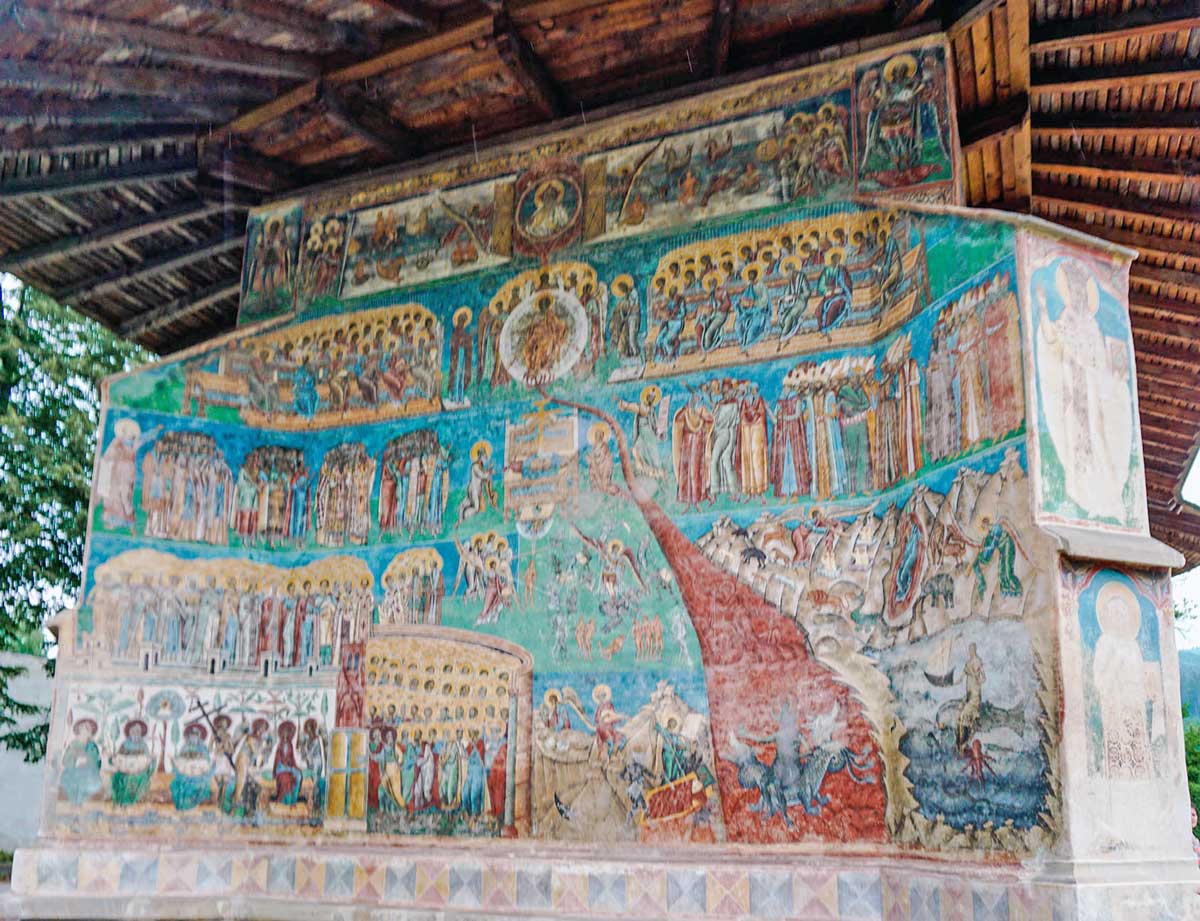
It’s also worth noting that eight of Bucovina’s painted monasteries have also been recognized internationally for their importance and are proudly listed on the UNESCO World Heritage List. These are: Arbore, Voronet, Humor, Moldovita, Sucevita, Patrauti, Suceava, and Probota.
However, Northern Moldova is dotted with numerous other churches that, even though not on the UNESCO list, are equally captivating and deserving of a visit. Among them it’s worth mentioning Putna, Neamt and Agapia.
Out of all the painted monasteries in Bucovina, Voronet stands out as the crown jewel. It is the most visited and celebrated, drawing visitors both locally and internationally.
One of its most striking features is the intense shade of blue present in its frescoes, famously dubbed as “Voronet blue.” This particular hue, with its deep richness and vibrancy, has puzzled and fascinated many.
And despite advancements in modern technology and artistry, the method of creating Voronet blue remains an enigma to this date, adding to the monastery’s allure.
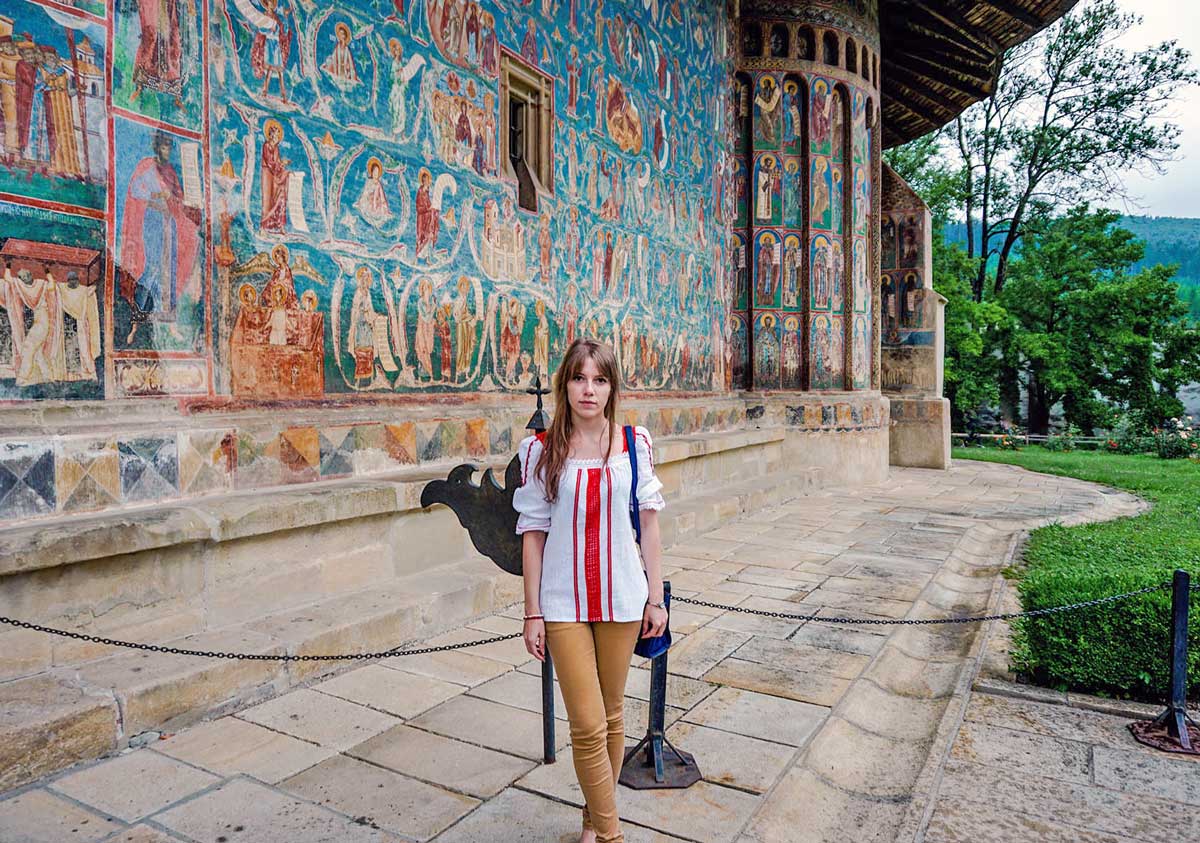
How to get to Bucovina and visit the painted monasteries?
The painted monasteries are located in Bucovina, a region in Northern Moldova, Romania. The main airport in the area is in Iasi, the unofficial capital of Moldova, followed by the one in Suceava.
However, Bucharest, the capital city, is often regarded as the ‘gateway’ to Romania because of its international airport, Henri Coanda, the biggest and most important in the country. It’s fair to say that most people will probably end up landing here.
The distance between Bucharest and Bucovina is roughly around 450 km (approx. 280 miles) which you can drive in about 6 hours depending on traffic conditions.
You can also fly or take a direct train to either Iasi or Suceava and once you’re there, you can rent a car to visit the monasteries (my recommended option) or use the local buses, which can be a bit of a daunting task.
This is because it’s usually hard to find information about the routes without asking the locals and the connections are not always the best.
I don’t know if it’s because Romanians use their personal cars a lot, or because there are so many different private bus companies across the country, but it’s pretty hard and frustrating to try and find information about intercity or rural bus routes online.
And this applies to me as well. And I know the language!
So a tip to remember: If you want to use the local transportation and Google is no help, just ask your host. As residents, they’ll either know themselves or know who to ask :)) and they’ll be happy to help.
Going back to our sheep, do take note that Iasi is not actually located in Bucovina, therefore it’s farther away from the monasteries than Suceava.
While it’s a beautiful city and worth a visit or day trip itself, I suggest you base yourself in Suceava instead, or even better, in one of the villages or towns around the monasteries. The area has many accommodation options to choose from.
Lastly, if you don’t want the hassle that comes with getting around by yourself, you can also visit the painted monasteries by tour. Here are several options to choose from:
- From Bucharest: 3-Day Bucovina & Transylvania Tour
- From Bucharest: 6-Day Transylvania and Bucovina Experience
- From Cluj: 2-Day Bucovina & Painted Monasteries Tour
Which painted monasteries in Romania should you visit?
Voronet Monastery
Access: car, bus from Gura Humorului
Nearest train stations: Gura Humorului
Admission fee: 5 lei (1 eur/1.2 USD)
Voronet is a medieval monastery in the village with the same name, part of the Gura Humorului town. As I already mentioned, it is the most known and visited monastery, most of its fame coming from the beautiful azure used as a dominant color in its frescoes.
Even though the chemical compounds of the color were analyzed in labs and we now know what stood at the base of the paint, it is still unknown how they were mixed to create the unique blue shade. Therefore it can’t be replicated.
The monastery was constructed by Stephan the Great (Stefan cel Mare) to commemorate his victory over the Ottoman Empire in the Battle of Vaslui.
The church features Gothic and Byzantine details. Its most important fresco is called The Last Judgement.
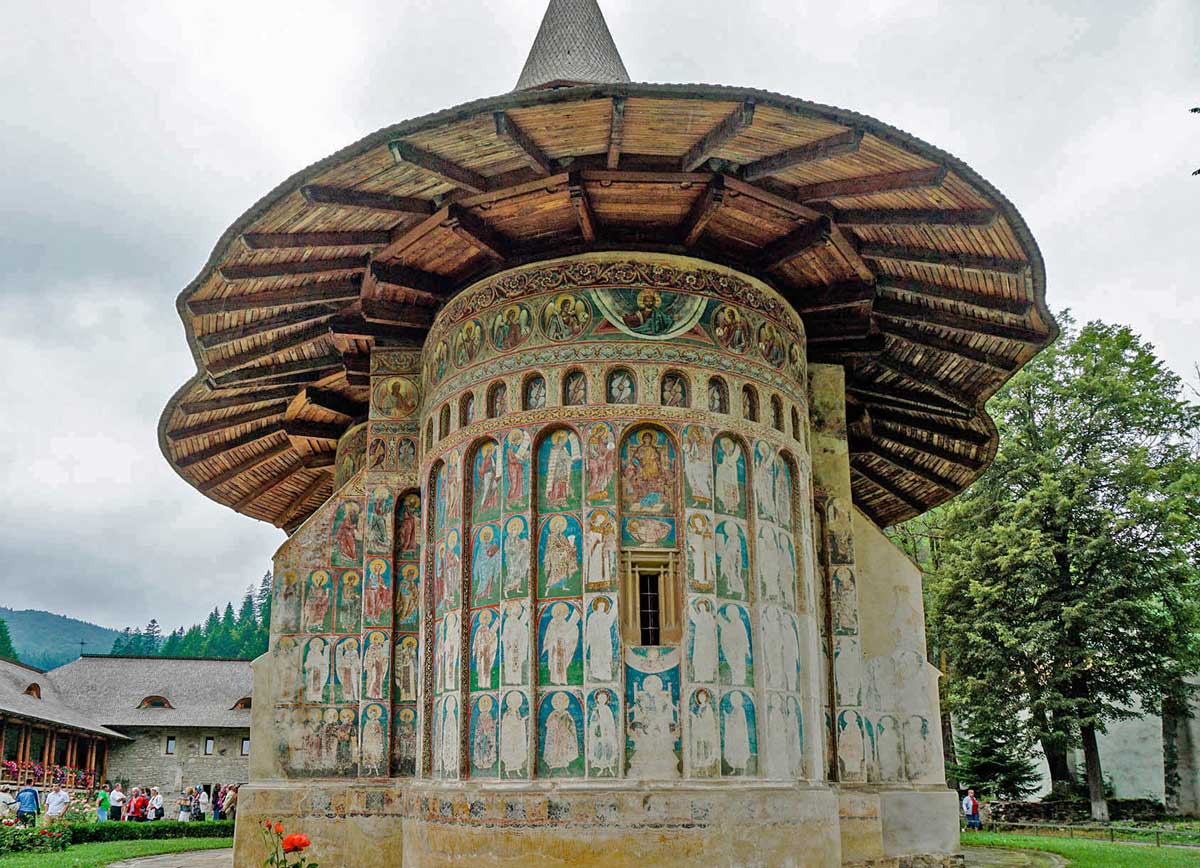
Sucevita Monastery
Access: car, bus from Radauti
Nearest train stations: Radauti, Vatra Moldovitei HC
Admission fee: 5 lei (1 eur/1.2 USD)
Sucevita was my favorite painted church. Its exterior frescoes dating from around 1601 are very well preserved since it was one of the last monasteries to be decorated in the famous Moldavian style of exterior paintings.
The monastery is located near Sucevita River, in the eponymous village. It was built in 1585 by Ieremia Movila, Gheorghe Movila and Simion Movila.
It features Gothic and Byzantine details, as well as some elements typical of the churches of Bucovina. Its most important fresco is Ladder of Virtues and the dominant color is green.
The interior court of the monastery is surrounded by a tall and wide wall. Each of its corners features a defensive tower.

Agapia Monastery
Access: car, bus from Targu Neamt
Nearest train stations: Targu Neamt
Admission fee: 5 lei (1 eur/1.2 USD)
Not exactly a painted monastery, Agapia is located in the commune Agapia, 9 km away from Targu Neamt city. It is one of the biggest nunneries in Romania, coming 2nd after Varatec.
Agapia’s church doesn’t feature exterior frescoes, but its interior was painted by the famous Romanian painter, Nicolae Grigorescu.
For this reason, the artistic style of the paintings is visibly different from other Bucovina monasteries.
The portraits of saints that he painted look so realistic, that it feels like they’re following you with their eyes as you walk inside the church, so make sure you pay attention to this.
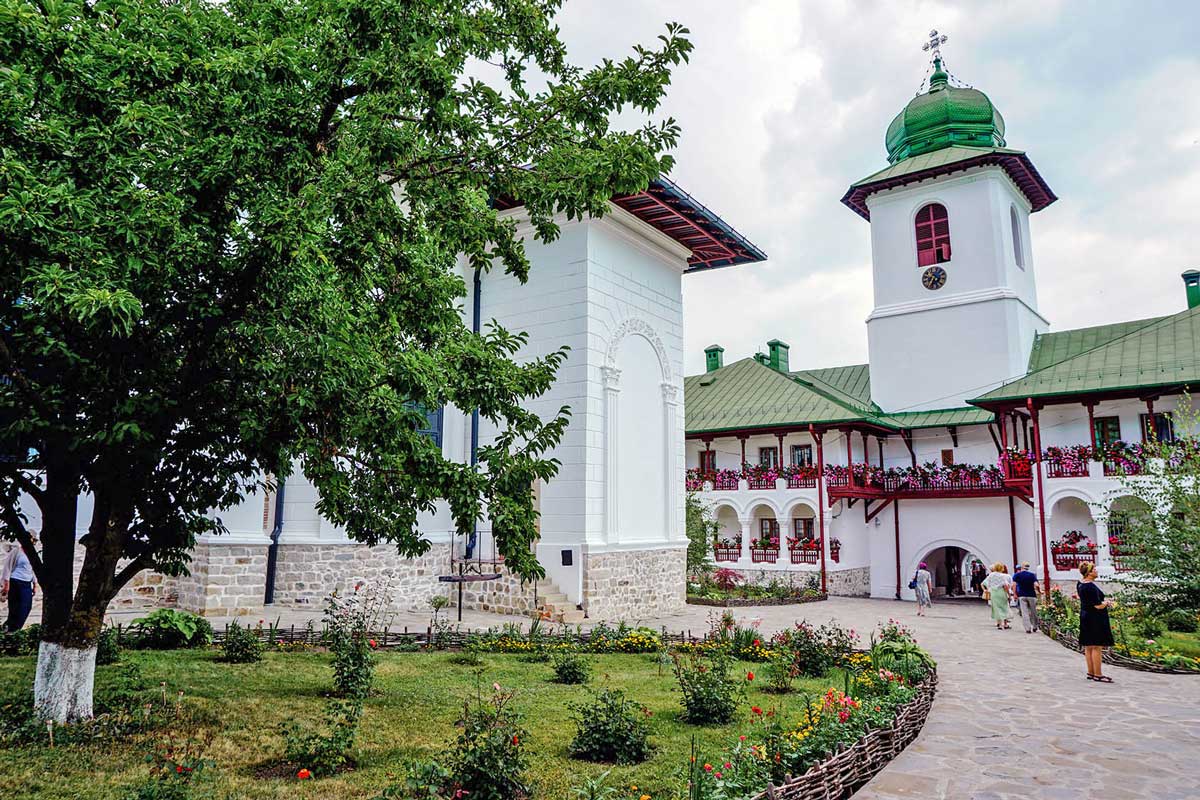
Moldovita Monastery
Access: car, train from Suceava to Vama: 1¼ hours,
and from Vama to Vatra Moldovitei: 35 min.
Nearest train station: Vatra Moldovitei HC
Admission fee: 5 lei (1 eur/1.2 USD)
Moldovita is a painted monastery located in the village of Vatra Moldovitei, Suceava county. It was built in 1532 by Petru Rares, Stephan the Great’s illegitimate son. Its dominant colors are gold and deep blue and its exterior paintings are very well preserved.
The Siege of Constantinople, depicting the Ottoman capture of the Byzantine capital is Moldovita’s most important fresco.
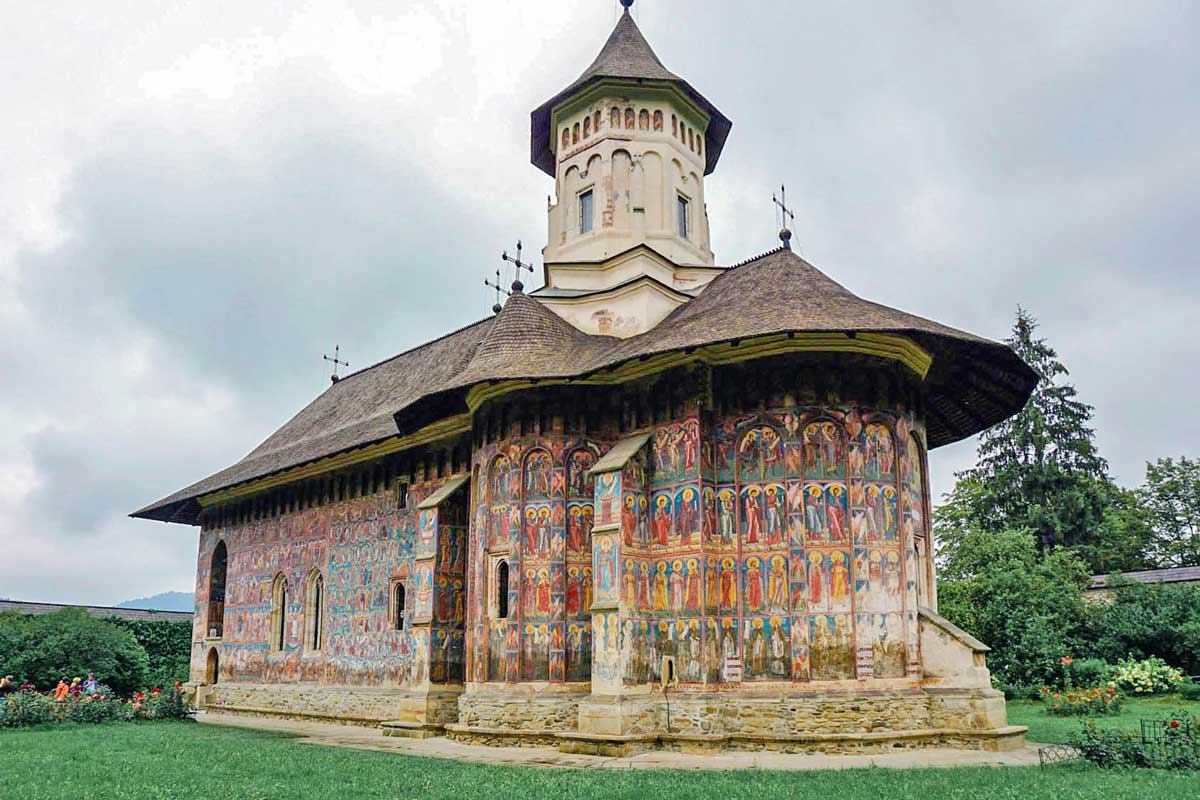
Humor Monastery
Access: car, bus from Suceva, train
Nearest train stations: Gura Humorului
Admission fee: 5 lei (1 eur/1.2 USD)
Humor monastery is located 5 km away from Gura Humorului town. It has exterior painted walls and its dominant color is reddish-brown.
There is a tower lookout in the same courtyard as the church which can be climbed for a bird’s eye view of the surroundings.
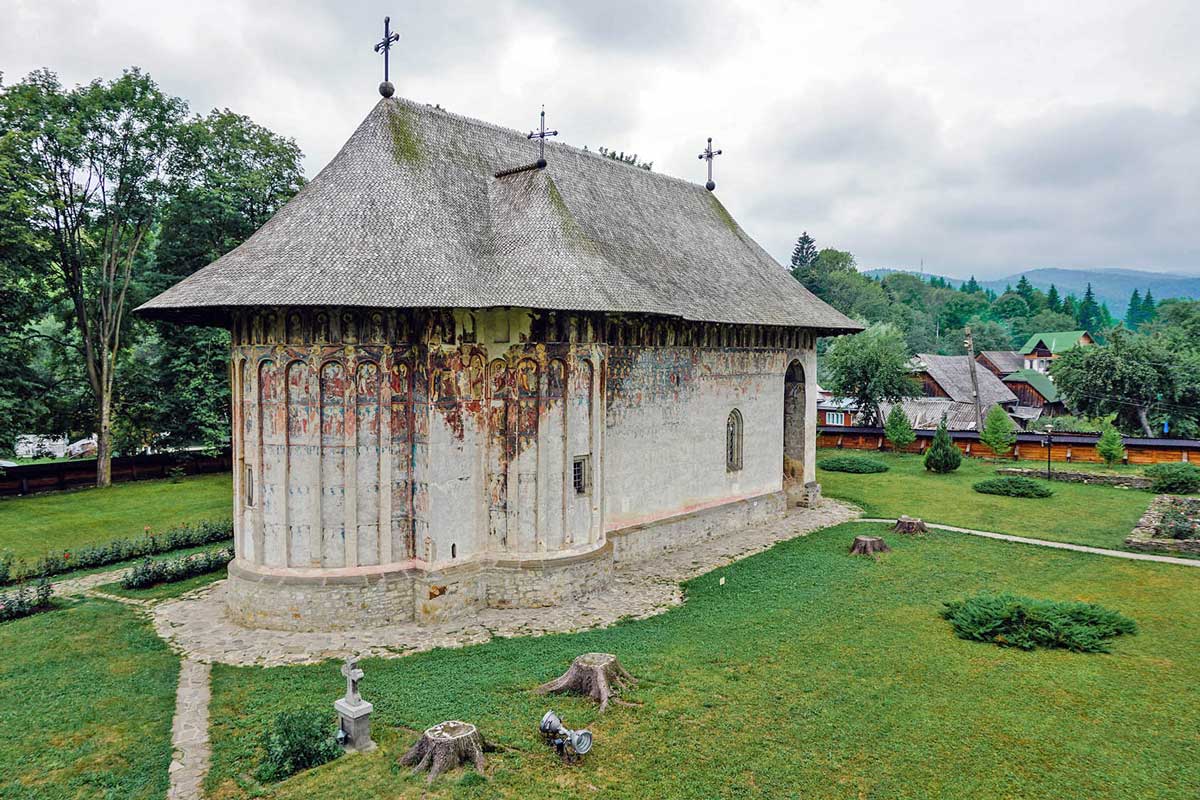
Putna Monastery
Access: car, bus from Radauti, train
Nearest train stations: Putna
Admission fee: The church is free to visit, but no pictures/videos are allowed inside (only outside for a fee of 10 RON). There is also a museum on the premises, available to visit for a fee.
Putna monastery, like many others, was founded by Stephan the Great – it was said that he built a church after each important military victory. After his death, the Moldavian ruler was buried here and so were a few other members of the family.
Sadly, the original church which had its outside walls painted with biblical stories was destroyed. It was later rebuilt by Vasile Lupu.
While the actual Putna doesn’t feature exterior mural paintings, the fact that it is the resting place of Stephan the Great keeps it close to the hearts of Romanians.
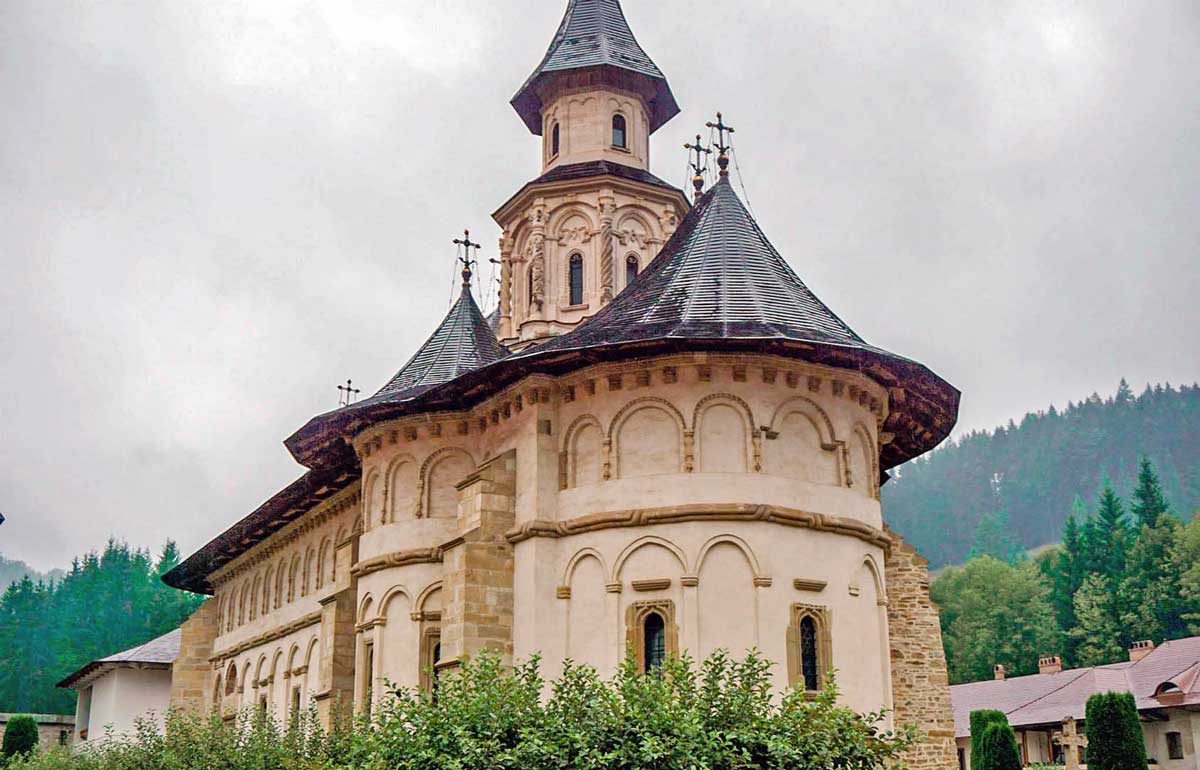
Neamt Monastery
Access: car, bus from Targu Neamt
Nearest train stations: Targu Neamt
Admission fee: 5 lei (1 eur/1.2 USD)
Neamt Monastery is another church built during the reign of Stephan the Great. Its facade is not painted, but it is covered with decorations characteristic of Stephan’s time: Gothic windows with enameled disks, colored green, yellow, and brown.
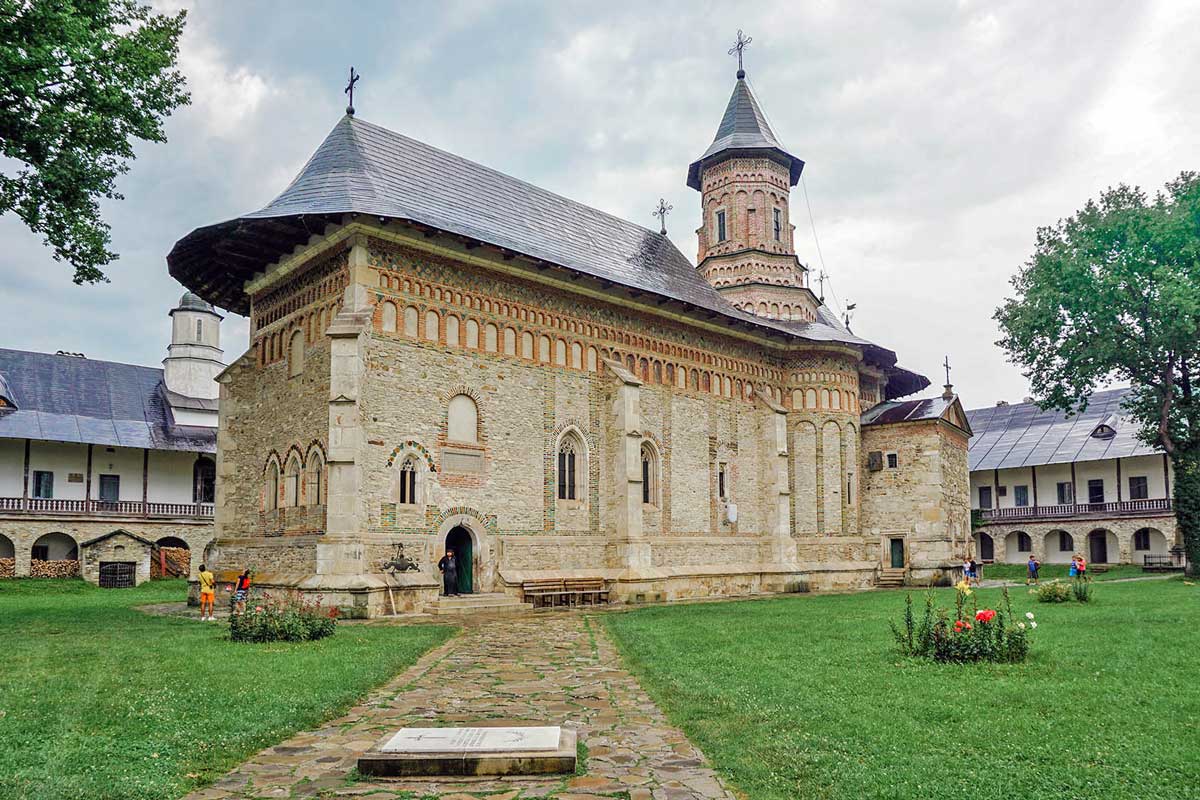
Guide for visiting Romanian Orthodox Monasteries
Given the fact that they are religious sites, most Orthodox monasteries impose a dress code when visiting – this is usually valid for any church in an Orthodox country be it Romania, Greece or Russia:
For men, the attire typically includes pants that cover the knees and shirts with sleeves.
Women are expected to wear skirts that go beyond the knee and shirts with sleeves that are modest in design. While some monasteries might also accept pants for women, it’s generally advisable to opt for a skirt or dress.
Additionally, while not always a strict requirement, women are often encouraged to cover their heads with a scarf.
If you arrive unprepared, don’t worry; many monasteries are accommodating and provide sarongs and scarves at the entrance to ensure visitors can experience the sacred space respectfully.
A word of warning: If you choose to ignore the rules, you might find yourself admonished by the nuns or monks. They can sometimes be really strict about them.
Final thoughts
If you’re looking for an off-the-beaten-path destination in Europe, consider Bucovina and its painted monasteries. With a unique history and beautiful landscape, it’s definitely worth the visit!
And if you have time to spare, cross the mountains into Maramures, another wonderful gem of Romania.
Happy travels~
YOU MIGHT ALSO LIKE
- Unique places to stay in Romania
- Visit the Muddy Volcanoes in Romania
- Visit Corvin’s Castle in Hunedoara
- Best towns in Transylvania
